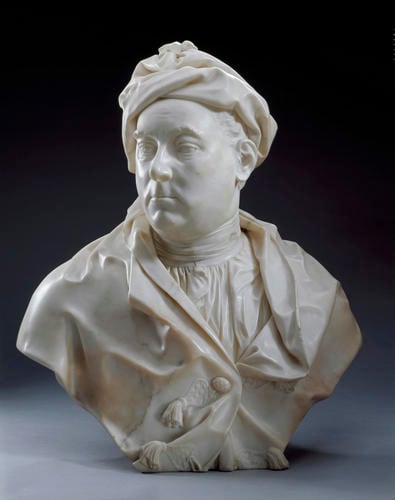-
1 of 253523 objects
George Frederick Handel (1685-1759) 1739
Marble | 71.0 x 60.0 x 36.0 cm (whole object) | RCIN 35255
-
A life-size white marble bust of the composer George Frederick Handel (1685-1759), head turned to the right, wearing a tasseled cap, pleated shirt and tasseled cloak. The back is hollowed and finely tooled. The waisted circular socle was a later addition and the bust since 2004 has been displayed without it.
Roubiliac made four portraits of Handel, of which the first, the famous statue of the seated figure with Apollo's lyre, commissioned for Vauxhall Gardens and completed in 1738, established the sculptor's reputation. The last was the composer's monument in Westminster Abbey.
It is perhaps Roubiliac's marble portraits rather than contemporary paintings by artists such as Thomas Hudson that present us with the persona of the inspired genius rather than the prosperous gentleman. In this bust, Handel is dressed well but in indoor garb of the kind worn in private, perhaps even while composing. The lop-sided, tasselled cap, carved with miraculous softness, and the disarranged coat are hallmarks of a sculptor intent on displaying every illusionistic trick, but also suggest a man careless of the material world, his mind on higher things. It should be remembered that the bust itself was intended for the composer's own home, not for any official setting.
By the time he sat for the portrait, Handel had enjoyed considerable success in London, and indeed the Vauxhall statue was the first of any living composer to be erected in his lifetime in London. He had composed more than forty operas in Italian and the great series of oratorios in English on Old Testament themes was already well under way. Having provided the music for George II's coronation in 1727, at the time he was sitting for this bust he was at work on the funeral anthem for Queen Caroline. In the previous year, 1737, he had suffered some kind of disorder or 'palsy', perhaps a minor stroke, arising no doubt in part from overwork, and he had been obliged to retire first to Tunbridge and then Aix la Chapelle to take the waters. Despite this, and the onset of blindness in the last ten years of his life, the bust depicts Handel with many of his greatest successes, including Messiah, still ahead of him.
John Christopher Smith the Younger, son of Handel's manager and principal copyist, was one of the composer's favourite pupils. Smith the Younger inherited many of Handel's possessions that had first been left to his father. They included '…my large Harpsichord, my little House Organ, my Musick Books, and five hundred Pounds sterl:' and may also have included the bust. Smith the Younger was appointed music teacher to Princess Augusta, widow of Frederick, Prince of Wales. According to Coxe, 'The Princess … derived so much satisfaction and improvement from his instructions, that she was often heard to say, that in her advanced age, she had acquired a new taste for music.' It was Smith the Younger who presented the bust, the harpsichord and the 'Musick Books' (the composer's manuscripts) to George III. The latter were presented to the British Library by H.M. The Queen in 1957.
Text adapted from The First Georgians: Art and Monarchy 1714 - 1760, London, 2014 and Sculpture in the Collection of His Majesty The King (2025).Provenance
Given by the sitter to his manager and copyist John Christopher (or Johan Christoph) Smith (1683-1763); his son, also John Christopher Smith (1712-95) who had been Handel's pupil; by whom given to George III, c.1772-4.
Four portraits of Handel by Roubiliac were made; the first, which made the sculptor's reputation, now in the Victoria and Albert Museum, London, another for Handel's tomb in Westminster Abbey from which a third was made, and this being the fourth. A terracotta in the collection of the Foundling Museum is thought to be Roubiliac's original model. Further plaster versions were sold by the sculptor.
In 1859 John Theed made a Parian porcelain reproduction of this work for sale in association with the Handel Commemoration at Crystal Palace. -
Creator(s)
Acquirer(s)
-
Medium and techniques
Marble
Measurements
71.0 x 60.0 x 36.0 cm (whole object)
Category
Object type(s)
Place of Production
England

